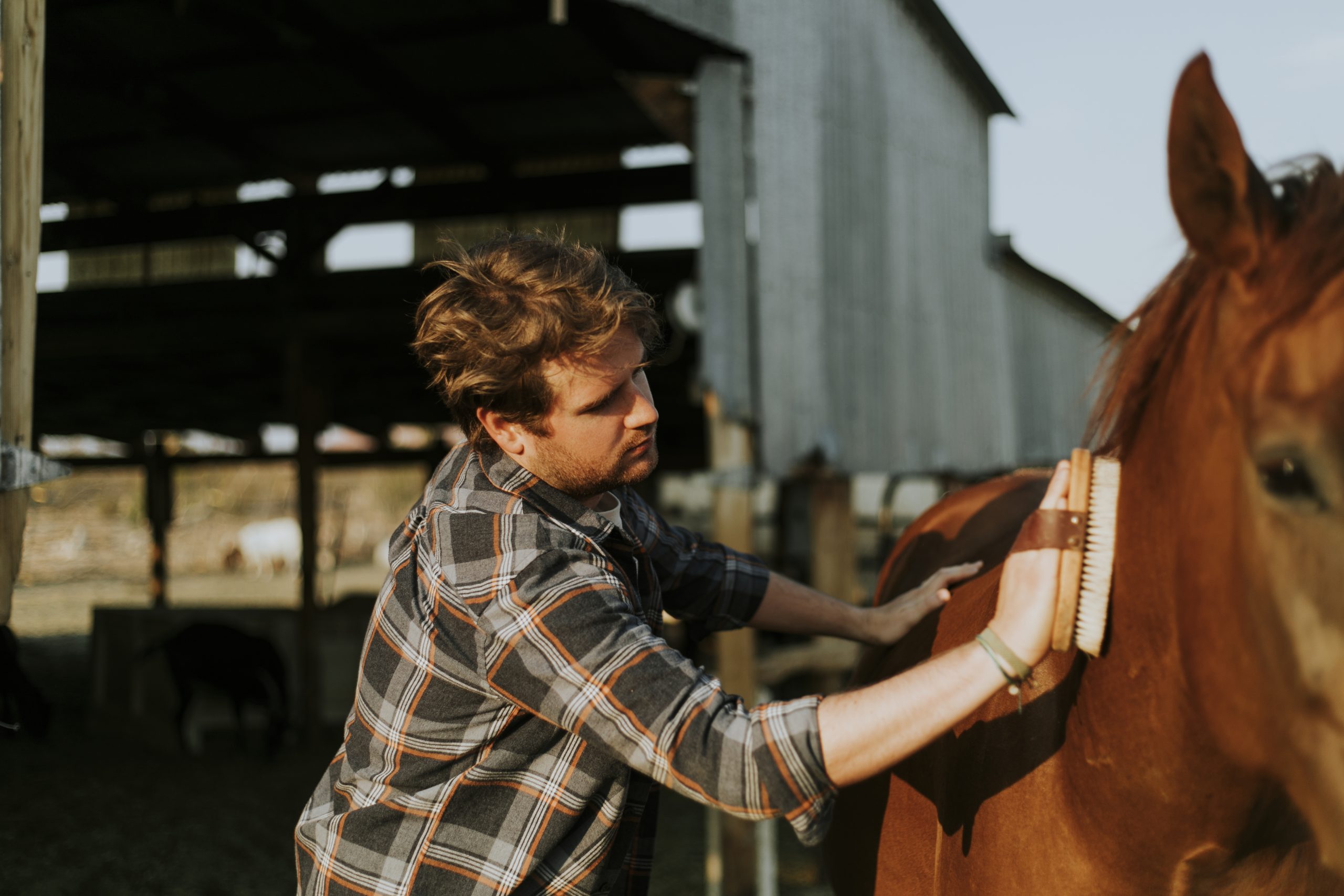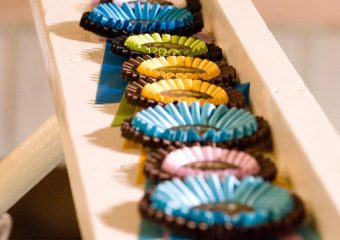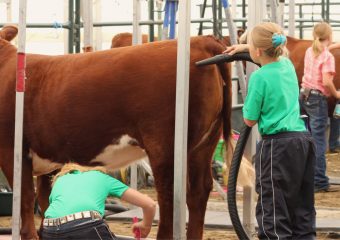Plans to make and supplies to gather before committing to self-care
Written by Erica Larson for TheHorse.com
I didn’t really choose to become a self-care boarder. I was happy with the care my Thoroughbred gelding, Dorado, received on full board. After years of having him at home, I enjoyed the extra time I had to check things off my to-do list.
But unexpectedly, Dorado suffered a laminitic episode. The barn staff caught it early, which allowed us to treat him quickly, but I still needed to medicate and check on him at least twice a day for the initial recovery period. I told the barn owner that I’d switch to self-care for the time being because I’d be at the farm so frequently. I never switched back.
Yes, it was a ton of work. And, yes, I spent significantly more time at the barn than when Dorado was on full board. But I found that I loved starting my day with Dorado. I enjoyed unwinding after work by cleaning a stall and going for a ride. And, even though picking up stable essentials meant an extra trip out at night or on weekends, I loved the freedom of selecting my own feed, hay, and bedding. I also
believe the extra time spent with Dorado strengthened our relationship.
All that to say: Self-care boarding takes a lot of time and effort, but it can be just what some horse owners need.
Before You Commence
Self-care board is what it sounds like: housing your horse at someone else’s facility but feeding and managing him yourself.
Bittersweet Acres, in Lexington, Kentucky, offers a range of boarding options. There, self-care includes a stall, turnout, and use of farm amenities such as a riding arena and grooming and wash stalls, says
Erica Higginbotham, who owns and operates the farm with her husband, Patrick.
Because the facility owners aren’t performing chores or providing feed, self-care boarding prices are typically lower than full-care options. But, ultimately, is it the least expensive option? Once you factor in time, supplies, and more, it might not be. So, it’s important to know what self-care boarding will involve and what resources it will require.
Know the basics: Horse care and health knowledge becomes especially important if you’re going to be providing that care yourself.
“Having an understanding of equine nutrition goals and the ability to assess your horse’s condition using the (Henneke body condition score) grading scale will be important when managing your horse’s diet and seasonal intake appropriately,” says Martha Rodgers, VMD, who owns and operates Shephard Hill Equine, a mobile practice in Lexington, Kentucky.
“Also, a basic understanding of equine anatomy will be helpful should your horse incur any injuries or lacerations that may be close to a joint or vital structure,” she adds, so you can report it to your vet. “General first-aid principles will always be important, and knowing the normal ranges for your horse’s resting heart rate, respiratory rate, and temperature are important so that any significant variation can be noted and documented.”
Know your horse: As a self-care boarder, you’re responsible for monitoring your horse and detecting abnormalities quickly.
Specifically, in addition to vital signs, Rodgers encourages owners to know their horses’ normal manure production; daily water intake; eating habits; activity level in the paddock; and stall behavior.
“Any changes in those normal parameters are an early warning sign to monitor your horse more closely, make any interventions necessary to ward off a potential gastrointestinal upset or colic episode, or
to contact your veterinarian,” she says.
Establish your equine health care team
Most self-care facilities don’t have a farm veterinarian and/or farrier. Therefore, it’s up to you to identify your horse’s care providers. If you don’t already have a preferred vet or farrier, consider getting references from other boarders and coordinating things like vaccination visits, fecal parasite egg count monitoring, etc. Doing so can save time and money. You also need to gather emergency contacts and establish an emergency plan.
“We ask our boarders to have posted at their stall their contact information, an emergency contact, and their preferred vet and farrier in cases of emergency,” Higginbotham says.
Don’t wait until a serious horse health issue arises to know how you’ll proceed. “Having a well-thought-out emergency plan is critical for a self-care boarder,” says Rodgers. “Discuss with your veterinarian
and the farm owner your wishes and constraints should an equine emergency arise which may need or warrant referral.”
Finally, be sure you have rapid access to a truck and trailer for emergency transport, whether it’s your own rig, the farm owner’s, or another boarder’s.
Know your limits: “The self-care boarder is definitely physically at the farm more and spends more time with their horse than our full-care boarders, on average,” Higginbotham says. “The self-care owner is out twice a day, turning out and then bringing in their horse and also cleaning the stall.”
This can be a perfect setup for hands-on horse owners. But the minutes add up quickly, especially for people with busy schedules. Even driving to and from the barn will take time out of the day.
Rodgers says developing relationships with other owners can be invaluable for self-care boarders.
“Having another boarder as a backup is key in case you are unavailable to meet your veterinarian or farrier for a more urgent need aside from a true emergency,” she says. “Specialized turnout schedules (post-injury, for example) or feeding/ muzzling schedules may be difficult for a working self-care boarder to manage. Sharing that responsibility will help the owner and keep the horse under the best
management for his needs.”
Having a barn buddy can also mean sharing day-to-day chores when one of you can’t get out to feed, muck stalls, or bring in or turn out horses.
You’ll also be spending time on feed, hay, and bedding runs; daily horse care tasks such as grooming and/or inspecting for injury; and riding, driving or otherwise having fun with your horse.
Be realistic, Higginbotham says, and ensure you have time in your schedule to take on a self-care commitment.
Don’t Forget Supplies
You might not own the barn, but you’ll need pretty much everything that goes inside it when you’re a self-care boarder.
Stable necessities
Some barns with self-care options, such as Bittersweet Acres, offer an assortment of community supplies. There, wheelbarrows, muck tubs, pitchforks, shovels, and brooms are available for use regardless of an owner’s boarding package. Other farms, however, require owners to bring their own stall care supplies, so check to be sure you’re prepared before moving in.
Other barn and stall essentials you might need to acquire include:
- Feed and water buckets (regular and heated or insulated for winter) for stalls;
- Water tanks for turnouts (some barns provide these or automatic waterers, so check with the facility owner);
- Haynets or feeders;
- Snaps or other fasteners; and
- If needed, a stall fan designed for outdoor or agricultural use.
If your horse will have a stall, plan for buying and storing bedding. Bittersweet Acres allows self-care owners to purchase shavings as needed from the farm stock, which means they don’t have to store their own products. Other facilities might require boarders to secure and store their own (be it on or off the property). Make arrangements with your farm owner in advance, and be willing to explore all options—for example, buying a bag of shavings from a local store might be marginally cheaper, but purchasing it from your barn and not having to worry about transportation and storage might end up being more convenient and worthwhile.
Horse care collection
Some full-care facilities provide everything from grooming and bathing supplies to fly spray and supplements. This won’t be the case when you’re self-care boarding. You’ll likely need to organize and store:
- A grooming kit;
- Bathing items;
- Hoof supplies;
- Insect control products;
- Extra halters and lead ropes;
- Blankets, sheets, coolers, and other
equine attire. If the barn has space
limitations, be prepared to store these
off-site when not in season; and - Tack and riding equipment.
Find out whether you’ll have access to a tack room or locker and/or if you’ll need to bring your own saddle and bridle rack, tack hooks, trunk, and other storage.
First-aid kit
Horses are masters at injuring themselves, and you’ll need to be well-prepared to deal with issues that arise. Rodgers recommends keeping the following on hand for emergencies:
- Limb and/or hoof poultice pads;
- Sterile nonstick dressing;
- Triple antibiotic ointment;
- Sheet cotton or a set of stable wraps;
- Self-adhesive flexible bandages; and
- Ophthalmic ointment from your veterinarian for eye wounds.
She also suggests asking your vet if he or she will prescribe a small stock of medications to keep on hand for emergencies. Rodgers stresses, however, that owners should always discuss administration with their veterinarians prior to medicating horses. Other first-aid kit essentials might include:
- Mild, unscented hand soap for cleaning wounds;
- Sterile saline solution for flushing eye and other wounds;
- A digital thermometer;
- A stethoscope to take pulse and respiration rates and listen to gut sounds;
- A hoof pick;
- A twitch;
- A good headlamp or flashlight;
- Normal and blunt-tip bandage scissors;
- Duct tape;
- An emergency phone number list; and
- Insurance information, if applicable.
Pro tips
Don’t forget to label or apply identifiers (halter plates, colored tape, etc.) to all your belongings. While it’s unlikely another boarder will deliberately swipe your supplies, it’s easy to mistake one curry comb for the next or grab what’s handy and forget to put it back.
Speaking of which, only use your equipment unless you’ve made prior arrangements with another boarder. It’s not only common courtesy to avoid using supplies that aren’t yours but also smart human and equine biosecurity to use certain equipment and tools only for certain people and horses.
Communication Is Key
Keeping lines of communication open between you, management, and other horse owners is important. As with any boarding situation, questions and conflicts are bound to arise.
Be sure you’re on the same page with your barn owner regarding expectations (What are the barn’s hours? Will new herdmates be added to your horse’s turnout without your knowledge?). Review your boarding contract, which should lay out expectations, and ask questions.
And don’t be a boarder who only surfaces to complain. Stay in contact regularly.
Take-Home Message
Self-care boarding can be time-consuming, difficult, and daunting. But it can also be the perfect arrangement for certain owners. It just takes some planning and preparation. “The most important thing is to be realistic regarding the time commitment involved in self-care and your ability to address many issues independently,” Rodgers says. “There are many online and local resources available to help you manage the care of your horse.”
Reprinted from TheHorse.com, July 2020
View the full article here https://thehorse.com/wp-content/uploads/2020/07/FarmBarn_July2020.pdf




